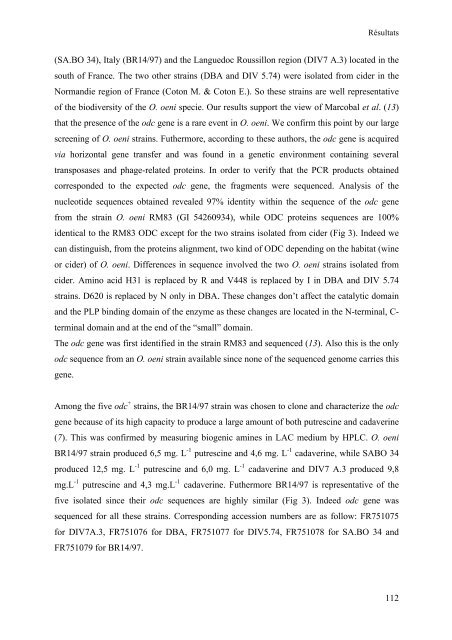THESE Maryse Bonnin Jusserand - Université de Bourgogne
THESE Maryse Bonnin Jusserand - Université de Bourgogne
THESE Maryse Bonnin Jusserand - Université de Bourgogne
Create successful ePaper yourself
Turn your PDF publications into a flip-book with our unique Google optimized e-Paper software.
Résultats<br />
(SA.BO 34), Italy (BR14/97) and the Languedoc Roussillon region (DIV7 A.3) located in the<br />
south of France. The two other strains (DBA and DIV 5.74) were isolated from ci<strong>de</strong>r in the<br />
Normandie region of France (Coton M. & Coton E.). So these strains are well representative<br />
of the biodiversity of the O. oeni specie. Our results support the view of Marcobal et al. (13)<br />
that the presence of the odc gene is a rare event in O. oeni. We confirm this point by our large<br />
screening of O. oeni strains. Futhermore, according to these authors, the odc gene is acquired<br />
via horizontal gene transfer and was found in a genetic environment containing several<br />
transposases and phage-related proteins. In or<strong>de</strong>r to verify that the PCR products obtained<br />
correspon<strong>de</strong>d to the expected odc gene, the fragments were sequenced. Analysis of the<br />
nucleoti<strong>de</strong> sequences obtained revealed 97% i<strong>de</strong>ntity within the sequence of the odc gene<br />
from the strain O. oeni RM83 (GI 54260934), while ODC proteins sequences are 100%<br />
i<strong>de</strong>ntical to the RM83 ODC except for the two strains isolated from ci<strong>de</strong>r (Fig 3). In<strong>de</strong>ed we<br />
can distinguish, from the proteins alignment, two kind of ODC <strong>de</strong>pending on the habitat (wine<br />
or ci<strong>de</strong>r) of O. oeni. Differences in sequence involved the two O. oeni strains isolated from<br />
ci<strong>de</strong>r. Amino acid H31 is replaced by R and V448 is replaced by I in DBA and DIV 5.74<br />
strains. D620 is replaced by N only in DBA. These changes don’t affect the catalytic domain<br />
and the PLP binding domain of the enzyme as these changes are located in the N-terminal, C-<br />
terminal domain and at the end of the “small” domain.<br />
The odc gene was first i<strong>de</strong>ntified in the strain RM83 and sequenced (13). Also this is the only<br />
odc sequence from an O. oeni strain available since none of the sequenced genome carries this<br />
gene.<br />
Among the five odc + strains, the BR14/97 strain was chosen to clone and characterize the odc<br />
gene because of its high capacity to produce a large amount of both putrescine and cadaverine<br />
(7). This was confirmed by measuring biogenic amines in LAC medium by HPLC. O. oeni<br />
BR14/97 strain produced 6,5 mg. L -1 putrescine and 4,6 mg. L -1 cadaverine, while SABO 34<br />
produced 12,5 mg. L -1 putrescine and 6,0 mg. L -1 cadaverine and DIV7 A.3 produced 9,8<br />
mg.L -1 putrescine and 4,3 mg.L -1 cadaverine. Futhermore BR14/97 is representative of the<br />
five isolated since their odc sequences are highly similar (Fig 3). In<strong>de</strong>ed odc gene was<br />
sequenced for all these strains. Corresponding accession numbers are as follow: FR751075<br />
for DIV7A.3, FR751076 for DBA, FR751077 for DIV5.74, FR751078 for SA.BO 34 and<br />
FR751079 for BR14/97.<br />
112

















